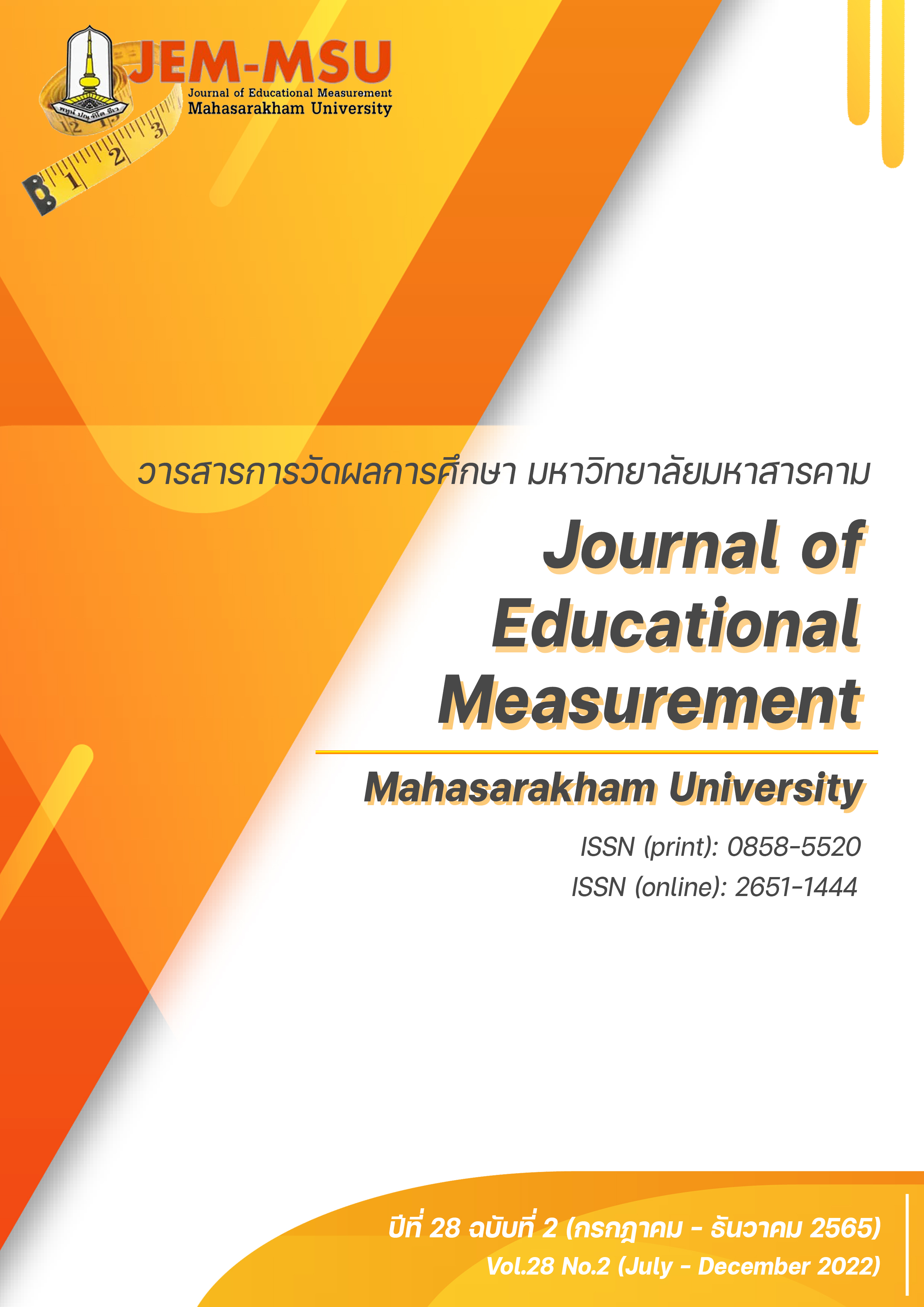A Multilevel Measurement Model of Digital Citizenship of Lower Secondary School Students in Mukdahan Province
Main Article Content
Abstract
The research aimed to develop and validate a multilevel measurement model of digital citizenship of lower secondary school students in Mukdahan Province at both the student level and the classroom level. The sample consisted of 1,632 students from 110 classrooms in 10 lower secondary schools in Mukdahan Province in the academic year 2020, obtained by multistage random sampling. The data were collected by using a questionnaire consisting of 48 items for measuring digital citizenship, with the discrimination of 0.22 to 0.61 and the reliability of 0.91. The analysis of data employed descriptive statistics, Pearson’s Product Moment Correlation Coefficient analysis and the Multilevel Confirmatory Factors Analysis: MCFA. The results of the study were as follows:
The multilevel measurement model of digital citizenship of the lower secondary school students at the student level and the classroom level comprised 8 observed variables: digital citizen Identity; screen time management; cyber bullying management; cyber security management; privacy management; media and information literacy; digital footprints and digital empathy. The multilevel measurement model had construct validity and was consistent with the empirical data in both the within and between levels: they were considered from indices used for checking validity of the model as = 36.69, df = 26, p = 0.08, RMSEA = 0.02, SRMRw = 0.01, SRMRb = 0.03, CFI = 0.99, TLI = 0.99 and
/df = 1.41, and the observed variables had the intraclass correlations (ICCs) located between 0.06 and 0.21. For the student level, media and information literacy had the highest factor loading (
= 0.92), followed by digital empathy and privacy management (
= 0.85). The lowest factor loading was digital citizen identity (
= 0.64). For the classroom level, digital footprints had the highest factor loading (
= 0.98), followed by media and information literacy (
= 0.95). The lowest factor loading was digital citizen identity (
= 0.82).
Article Details

This work is licensed under a Creative Commons Attribution-NonCommercial-NoDerivatives 4.0 International License.
The content and information contained in the published article in the Journal of Educational Measurement Mahasarakham University represent the opinions and responsibilities of the authors directly. The editorial board of the journal is not necessarily in agreement with or responsible for any of the content.
The articles, data, content, images, etc. that have been published in the Journal of Educational Measurement Mahasarakham University are copyrighted by the journal. If any individual or organization wishes to reproduce or perform any actions involving the entirety or any part of the content, they must obtain written permission from the Journal of Educational Measurement Mahasarakham University.
References
Diamantopoulos, A. & Siguaw, J. A., (2000). Introduction to LISREL: A guide for the uninitiated. SAGE Publications, Inc.
DQ Institute. (2019). Digital intelligence (DQ): DQ Global Standards Report 2019 Common Framework for Digital Literacy, Skills and Readiness. http://www.dqinstitute.org/wp-content/uploads/2019/11/DQGlobalStandardsReport2019.pdf
Fan, X. & Sivo, S. (2005). Sensitivity of fit indexes to misspecified structural or measurement model components: Rationale of two-index strategy revisited. Structural Equation Modeling, 12(3), 343-367.
Muthen, B. O. (1989). Latent variable modeling in heterogeneous populations. Psychometrika, 54(4), 557-585.
Park, Y. (2019). IQ, EQ, and DQ. https://www.dqinstitute.org/wp-content/uploads/2019/11/DQGlobalStandardsReport2019.pdf
Snijders, T. A. B., & Bosker, R. J. (1999). Multilevel analysis: An introduction to basic and advanced multilevel modeling. Thousand Oaks: Sage Publications.
Angsuchoti, S., Wijitwanna, S. & Pinyopanuwat, R. (2009). Analytical statistics for research Learning Theory and Learning Behavior, Lisrel Programming Techniques (3th ed.). CDMKprinting. (in Thai)
Biggins, O. (2012). Media and Information Literacy. Journal of SUDDHIPARITAD Review, 26(80),147-161. (in Thai)
Center for the Promotion and Protection of Children and Youths in the Use of Online Media. (2019). Report on the situation of Thai children and online dangers 2019 on August 19, 2019 at the Department of Children and Youth Affairs. Ministry of Social Development and Human Security. https://inetfoundation.or.th/ Welcome/activity?id=59 (in Thai)
Chadcham, S. & Kornpetpanee, S. (2004). Structural Equation Modeling. Journal of educational researcch and measurement, 1(1), 1-24.
Child Media. (2020). DQ Digital Intelligence (3th ed.). Child Media. http://cclickthailand.com/ wpcontent/uploads/2020/04/dq_FINAL.pdf?fbclid=IwAR3sPj6MS_MMn1Qv13h314GSUDF5z3Oq9KfC397jpGATe98HAvjmQ30BMo (in Thai)
Kaiyawan, Y. (2013). Multivariate statistical analysis for research. Chulalongkorn University Press. (in Thai)
Kanjanawasee, S. (2011). Classical Test Theory (5th ed.). Chulalongkorn University Press. (in Thai)
Phornprasert, W. (2019). The development of students digital citizenship scale and norms in higher education institutions (Phitsanulok) [Doctor’s thesis]. Naresuan University. (in Thai)
Sarnnok, K. & Wannapiroon, P. (2018). Applying Internet of Everything Technology to Create a Ubiquitous Learning Environment for Digital Native. Journal Of Association of Private Higher Education Institutions of Thailand under the Patronage of Her Royal Highness Princess Maha Chakri Sirindhorn, 7(1), 124. (in Thai)
Thumbsup. (2016). Know the new indicators “DQ” Digital genius with 8 skills that children must be used wisely. http://thumbsup.in.th/ 2016/10/how-digital-intelligence-important-for-all-children/ (in Thai)


